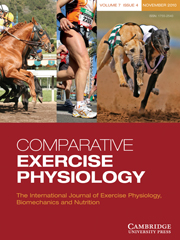Article contents
Evidence supporting exercise-induced pulmonary haemorrhage in racing greyhounds
Published online by Cambridge University Press: 01 February 2008
Abstract
Exercise-induced pulmonary haemorrhage (EIPH) is a major health concern in performance horses, but the presence and severity of this condition in racing greyhounds has received little attention. While equids and greyhounds share many physiological attributes, there are important structural and functional differences that may help protect greyhounds from EIPH. We tested the hypothesis that greyhounds performing a simulated 503 m race would experience EIPH and that the time course of recovery would be similar to the horse, even though the severity or relative extent as indexed by the concentration of red blood cells [RBCs] in bronchoalveolar lavage (BAL) fluid would be lower in comparison with that demonstrated previously in horses. Greyhound dogs (n = 6) raced on two occasions (separated by 7 weeks) and BAL was performed 1 week before, 2 h after and each week for 4 weeks following each race to examine the [RBC], concentration of white blood cells [WBCs], WBC differentials and haemosiderophages in the lungs. Racing increased 10 min post-exercise venous blood [lactate] to 18.6 ± 0.4 mmol l− 1. No epistaxis or pink froth was observed at the nose or mouth of any of the dogs. The [RBC] in the BAL fluid was increased significantly 2 h post-race (baseline = 109.6 ± 11.7 × 103; post-race = 292.3 ± 69.9 × 103 RBC ml− 1 BAL fluid, P < 0.05) and returned to baseline 1 week post-race (149.2 ± 46.2 × 103 RBC ml− 1 BAL fluid, P>0.05 versus baseline). The number of haemosiderophages was not different for any of the measurement periods. The [WBC] in the BAL fluid decreased from baseline and race values at 2, 3 and 4 weeks post-exercise (all P < 0.05). Alveolar neutrophil concentrations were also decreased from baseline and immediate post-race values for 4 weeks post-race. The increased [RBC] in the BAL fluid post-exercise is consistent with the presence of EIPH in these greyhounds. However, the relative extent of EIPH in greyhounds (as indexed by [RBC] in the BAL fluid), as compared with that in the horse, was mild, and the lack of elevation of WBC suggests that, unlike their equine counterparts, inflammatory airway disease was absent.
Information
- Type
- Research Paper
- Information
- Copyright
- Copyright © Cambridge University Press 2008
References
- 8
- Cited by

